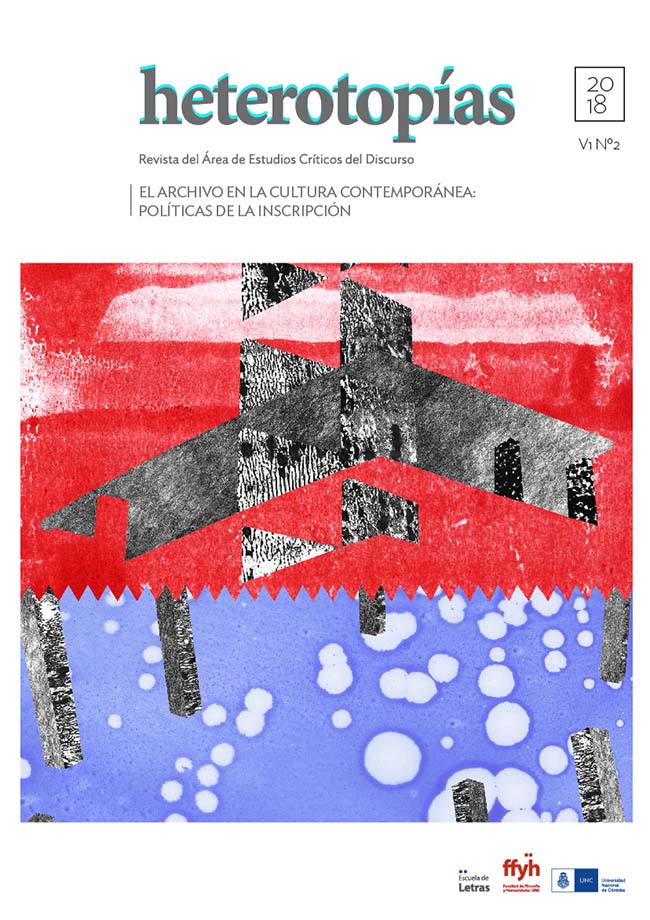Declassification of secret archives: politics and police in the becoming of human rights.
Main Article Content
Abstract
Starting from the phenomenon of declassification of secret files associated with violence on human rights, we are interested in observing some cases of declassification debated between two types: state policies, Chile Declassification Project (1999); and community micropolitics derived from art, Desclasificación Popular (2014). Considering the secret dimension of these archives, as well as the historical-political problem that they reveal, these cases will be relevant to us to examine the aesthetic regime of declassification, whose strange dimension we will address through the categories proposed by Rancière, such as the politics and the police.
Downloads
Article Details
Those authors who have publications with this journal, accept the following terms: Those authors who have publications with this journal, accept the following terms:
a. The authors will keep their copyright and guarantee to the journal the right of first publication of their work, which will be simultaneously subject to the Creative Commons Attribution - Non-Commercial - Share Alike (by-nc-sa) Attribution License; no commercial use of the original work or any derivative works is allowed, the distribution of which must be done with a license equal to the one that regulates the original work.
b. Authors may adopt other non-exclusive license agreements for the distribution of the published version of the work (e.g., deposit it in an institutional telematic archive or publish it in a monographic volume) provided that the initial publication in this journal is indicated.
c. Authors are allowed and recommended to disseminate their work through the Internet (e.g. in institutional telematic archives or on their website) before and during the submission process, which may lead to interesting exchanges and increase the number of citations of the published work. (See The effect of open access).
How to Cite
References
BENJAMIN, Walter (2005), “Convoluto N: Teoría del conocimiento, teoría del progreso”. En Libro de los Pasajes (pp. 459-490). Akal: Madrid.
COOK, Terry (2001). “Fashionable Nonsense or Professional Rebirth: Postmodernism and the Practice of Archives”. Archivaria 51, 14-35.
___________ (1994). “Electronic records, paper minds: the revolution in information management and archives in the post-custodial and post-modernist era”. Archives and Manuscripts 22(2), 300-328.
GÓMEZ-MOYA, Cristián (2015). “Tachas como secretos devenidos en documentos de arte contemporáneo [apéndice: el secretario]”. En Soledad García y Brandon LaBelle (eds.). Block Mágico (pp. 62-75). Santiago: Errant Bodies Press.
_________ (2016). “Estéticas de la documentalidad en los derechos humanos: una espectrografía de la desclasificación”. ERRATA #13, 28-49.
GROYS, Boris (2008a). “From Image to Image File-and Back: Art in the Age of digitalization”. En Art Power (pp. 83-91). Cambridge/Masachusetts: The MIT Press.
___________ (2008b). “El arte en la era de la biopolítica: de la obra de arte a la documentación de arte”, en Obra de arte total Stalin. Topología del arte (pp. 165-183). La Habana: Centro Teórico-Cultural Criterios.
___________ (2005a). “The Fate of Art in the Age of Terror”. En Bruno Latour and Peter WEIBEL (eds.). Making Things Public. Atmospheres of Democracy (pp. 970-977). Cambridge/ London: MIT Press.
_________ (2005b). Sobre lo nuevo. Ensayo de una economía cultural. Valencia: Pre-textos.
HAMILTON, Carolyn, et. al. (2002). Refiguring the Archive. Dordrecht: Kluwer Academic Publishers.
COMISIÓN VALECH (2004). Informe Comisión Nacional sobre Prisión Política y Tortura (I y II). Disponible en: http://bibliotecadigital.indh.cl/handle/123456789/455 (consultado: 16/04/2014).
MITCHELl, William John Thomas (2009). Teoría de La Imagen. Madrid: Akal [versión original: Picture Theory, 1994].
MORRIS, Charles E. (2006). “The Archival Turn in Rhetorical Studies; Or, the Archive's Rhetorical (Re)turn”. Rhetoric & Public Affairs, 9(1), 113-115.
OPASO, Cristián, “Proyecto de acuerdo-intervención de la CIA”, Santiago, 15 de noviembre de 2000. En “¡FORGET IT! Documentos Desclasificados de EEUU”, El Periodista, 18 de enero de 2004. Disponible en: http://www.elperiodista.cl/newtenberg/1563/article-57347.html/ (consultado: 10/04/2014).
RANCIÈRE, Jacques (2010a). “The Use of Distinctions”. En Dissensus. On Politics and Aesthetics (pp. 205-218). NY/London: Continuum [versión en castellano: El Uso de las Distinciones (2004). Disponible en: http://www.mesetas.net (consultado: 11/02/2014)].
_________ (2010b). “Les images veulent-elles vraiment vivre?”. En Alloa, Emmanuel (ed.) (2010). Penser l’Image (pp. 249-266). Les presses du réel: Paris [versión en castellano: “¿Quieren realmente vivir las imágenes?”, Cuadernos de Teoría y Crítica, 2 (2016), 75-88].
___________ (2009). El reparto de lo sensible. Estética y política. Santiago: LOM Ediciones [versión original: Le partage du sensible, 2000].
___________ (2006). “Política, identificación y subjetivación”. En Política, Policía, Democracia. Santiago: LOM Ediciones.
___________ (2005). El viraje ético de la estética y la política. Santiago: Palinodia.
___________ (1994). En los bordes de lo político. Santiago: Universitaria [versión original: Aux bords du politique, 1990].
ROJAS, Sergio (2012). El arte agotado. Santiago: Sangría.
SCHWARTZ, Joan M. & Cook, Terry (2002). “Archives, Records, and Power: The Making of Modern Memory”. Archival Science 2, 1-19.
UNITED STATES SENATE (1975). “Select Committee to Study Gobernmental Operations with Respect to Intelligence Activities of the United States Senate”. Alleged Assassination Plots Involving Foreign Leaders. Disponible en: http://www.archives.gov/ (consultado: 02/04/2014)
___________ Cover Action in Chile, 1963-1973 disponible en: http://www.archives.gov/ (consultado: 02/04/2014). La versión en castellano, ha sido traducida desde la versión original en inglés por el Equipo Nizkor, una organización internacional para el respeto y la promoción de los derechos humanos. Disponible en: http://www.derechos.org/nizkor/chile/doc/encubierta.html (consultado: 02/04/2014).
U. S. Department of State, Chile Declassification Project: (human rights in Chile-Tranche 1), Washington, D.C., The Department of State, Freedom Of Information Act (FOIA), USA, 1999. 29 v.: facsíms. + 5 supl. en 9. Algunas partes del proyecto también se encuentran disponibles digitalmente en: http://foia.state.gov/Search/Collections.aspx (consultado: 10/04/2011).
WRIGHT, Stephen (2013). Toward a Lexicon of Usership, NH Eindhoven, NL: Van Abbemuseum.
